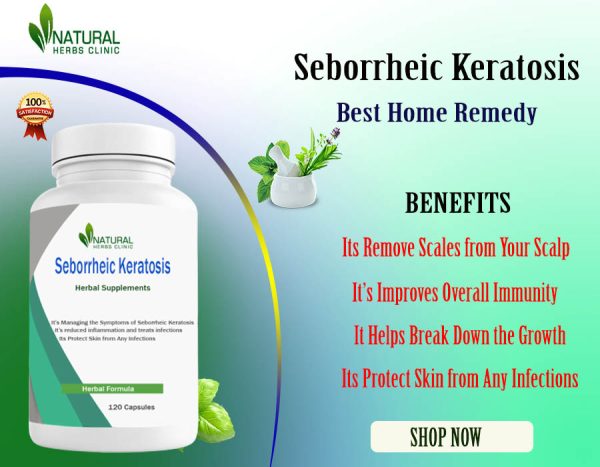If you have this skin condition, it has been demonstrated that using Home Remedies for Seborrheic Keratosis such as apple cider vinegar and tea tree oil can help with the discomfort and appearance of the condition.
Defining Seborrheic Keratosis
Seborrheic keratosis, a common skin condition, can cause lumps or rough skin patches. Along with some straightforward medical procedures, there are a number of natural treatments that can be used to cure these pimples. In this blog post, we’ll discuss the many natural treatments for seborrheic keratosis to assist you in making the best decision.
The Causes and Symptoms of Seborrheic Keratosis
Benign skin growths may develop as a result of the common skin condition seborrheic keratosis. Although the actual cause of the growths is unknown, they seem to increase in frequency as people get older. To lessen or eliminate these growths, there are natural remedies that can be administered topically, such as apple cider vinegar, tea tree oil, and coconut oil. Dietary changes and natural supplements that might help strengthen immunity and minimize symptoms are some examples of all-natural remedies. But, it’s important to keep in mind that natural treatments for seborrheic keratosis could not be as effective as traditional medical procedures, and they might even be ineffective. So, it is essential to speak with a qualified healthcare professional before beginning natural remedies for your skin condition.
Seborrheic keratosis is typically characterized by raised, waxy-appearing pimples on the skin that can range in color from yellowish-brown to black. These lumps may be uncomfortable or sensitive, and they may appear singly or in clusters on any portion of the body. Last but not least, seborrheic keratosis is a skin condition that commonly shows up as raised, waxy-looking lumps on the skin. These pimples range in color from yellowish-brown to black and may be painful or irritable. Seborrheic keratosis is typically not hazardous, but if you wish to treat the condition, there are natural solutions available.
Strategies for Treating Seborrheic Keratosis are Examined
Seborrheic keratosis treatment options need to be carefully studied to produce the best outcomes. In some cases, therapy other than freezing, burning, or surgical removal may be more effective for a given patient’s needs. One method of natural treatment for seborrheic keratosis uses creams with ingredients like salicylic acid and glycolic acid, which help the lesion slough off over time. Rarely, natural remedies like apple cider vinegar or tea tree oil may be used to treat seborrheic keratosis in order to reduce swelling. Therefore, it’s important to speak with a doctor or dermatologist to determine which seborrheic keratosis treatment is best for you and your particular situation.
Despite the possibility of temporary redness or swelling where it is applied, liquid nitrogen cryotherapy can effectively treat seborrheic keratosis. It is essential to speak with a healthcare provider about any potential side effects and the most practical course of action before deciding on cryotherapy as a treatment. There are other natural solutions to consider in addition to cryotherapy as a treatment for seborrheic keratosis. Many people learn that seborrheic keratosis can be reduced in size and appearance by adopting natural treatments like castor oil, apple cider vinegar, and tea tree oil. It is best to see a medical expert before attempting any form of natural treatment for seborrheic keratosis.
Benefits of Home Remedies for Seborrheic Keratosis Treatments
Natural Remedy for Seborrheic Keratosis provides a variety of advantages over medical therapy, including not requiring time off from work or school for doctor visits, saving money on medical bills, and preventing the possibility of severe medication side effects. One of the many easy at-home remedies for seborrheic keratosis is the use of natural oils and herbs that can halt or decrease the growth of lesions. Natural Remedies for Seborrheic Keratosis are typically affordable because many natural ingredients are available at grocery stores and health food stores. Last but not least, because they are less likely to have any unwanted side effects, utilizing natural therapies is a safe and viable option.
Seborrheic Keratosis Natural Treatment typically provides faster relief than medical therapies and is just as effective, so you may get back to your life sooner rather than later without sacrificing the quality of your care. Moreover, natural seborrheic keratosis treatments are a great way to get rid of the problem quickly. Because they can have effects that are just as powerful as medical treatments and may even provide faster relief, you won’t have to wait long for your symptoms to go away. Natural cures are a great way to revive yourself as soon as possible without lowering the quality of your treatment.
Home Remedies for Seborrheic Keratosis
For those seeking natural therapies, apple cider vinegar, and tea tree oil both have the potential to decrease the appearance of seborrheic keratosis. Apply the concoction to the seborrheic keratosis-affected area with a cotton ball after combining equal parts apple cider vinegar and water. Leave on for 10 to 15 minutes, then rinse with warm water. Tea tree oil can be diluted with a teaspoon of coconut oil or jojoba oil and administered topically to treat seborrheic keratosis. Rinse with warm water 10 minutes later. Any cure might need to be used more than once over time in order to show results.
Seborrheic keratosis-related redness and inflammation can be reduced with the aid of tea tree oil, a natural anti-inflammatory. Acetic acid, which is included in apple cider vinegar, can assist in exfoliating the epidermis. Once more, those who suffer from seborrheic keratosis can benefit from natural remedies for the condition including tea tree oil and apple cider vinegar. While the acetic acid in apple cider vinegar can aid in the removal of the top layer of skin, tea tree oil is a natural anti-inflammatory that can help reduce redness and irritation. These natural remedies could provide relief from the symptoms of seborrheic keratosis.
Investigating Herbal Remedies for Seborrheic Keratosis
The investigation of traditional herbal remedies’ potential as seborrheic keratosis treatments is an intriguing development in SK research. Seborrheic keratosis, a common non-cancerous skin development, appears as a raised, black area on the epidermis. Despite the fact that seborrheic keratoses are mostly benign, traditional therapies occasionally call for some kind of chemical or physical excision. As a result of research into traditional herbal therapies, there is increased interest in adopting natural treatments to treat seborrheic keratosis without surgically removing it. Research on seborrheic keratosis has advanced, creating new opportunities for the effective and safe treatment of this common skin condition.
We need to take into account both their efficacy and negative effects in order to determine whether specific herbs and plant-based ingredients may be utilized safely and effectively for SK treatment. Although there has long been some use of home treatments for seborrheic keratosis, there is still scant scientific data to back up their efficacy. Traditional home remedies usually use natural ingredients like tea tree oil, apple cider vinegar, aloe vera, and others. Although some home treatments may be beneficial for some people, others contain risks and should only be used with caution and medical guidance. Before using any home remedies, a doctor should be consulted, and they should never take the place of topical treatments that have been prescribed by a professional.
Also, we must conduct suitable clinical trials to evaluate the efficacy, safety, and possible negative effects of these herbal remedies for seborrheic keratosis. Also, you should consult a doctor before using any at-home remedies for seborrheic keratosis. Home remedies may provide some temporary comfort, but it’s important to ensure that they are secure and efficient by carrying out the necessary clinical investigations to evaluate their efficacy and any potential adverse effects. This is an important step because utilizing home remedies incorrectly or without enough expertise can potentially cause skin damage.
Apple Cider Vinegar
Seborrheic keratosis can be treated topically with organic, raw apple cider vinegar. Use a mixture of one part apple cider vinegar to three parts water if the seborrheic keratoses are on the face. The seborrheic keratosis is subsequently treated with the solution two to three times each day.
Apple cider vinegar can be used with a cotton ball to any keratoses on other body parts. Add a skin protectant, such as castor oil, to healthy skin before covering the cotton ball with a bandage. Use this cure exclusively at night, or swap out the cotton ball and apple cider vinegar bandage after 12 hours.
Castor Oil
One of the effective topical Home Remedies for Seborrheic Keratosis is castor oil. Only twice every day, apply castor oil to the new skin growth. Castor oil may be the greatest treatment for people with sensitive skin because it is calming and beneficial to the skin in general.
Aloe Vera
Apply aloe vera gel twice daily to the seborrheic keratosis in a manner similar to how castor oil is used. Search for aloe vera products that don’t contain a lot of chemical additives. You might also use fresh aloe from your own plant.
Even while it will take time for any of these treatments to entirely cure seborrheic keratosis, results are often seen within a week or two.
Last Word
In conclusion, there are a variety of Home Remedies for Seborrheic Keratosis. Natural Remedies for Seborrheic Keratosis are frequently a better option despite the fact that there are drug solutions for this issue because they may be used at home without worrying about negative side effects.




